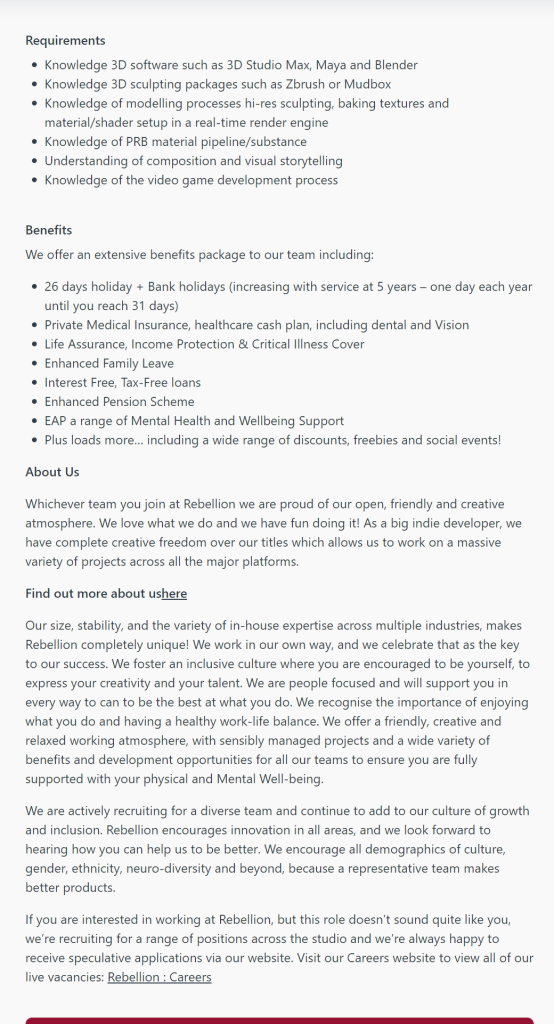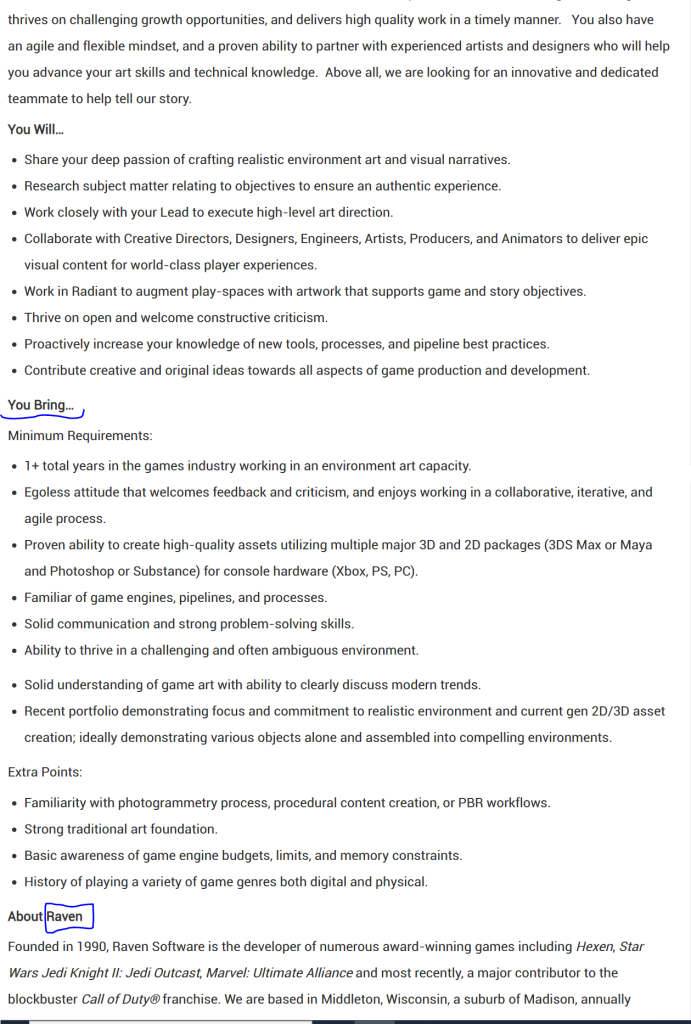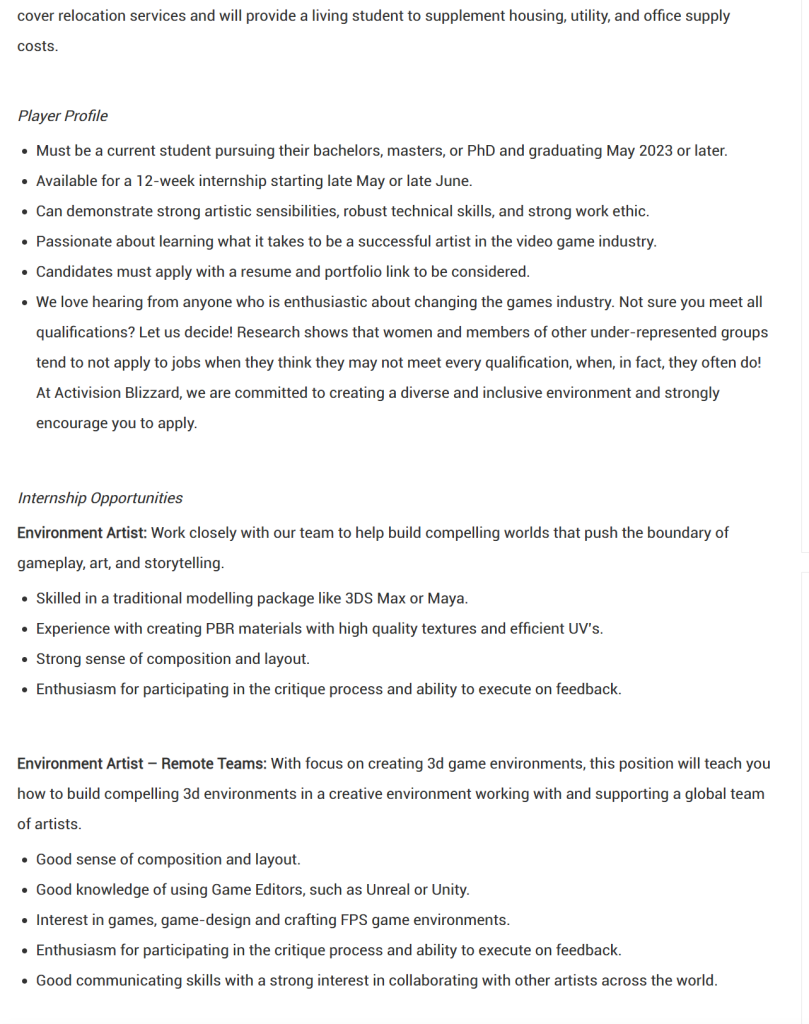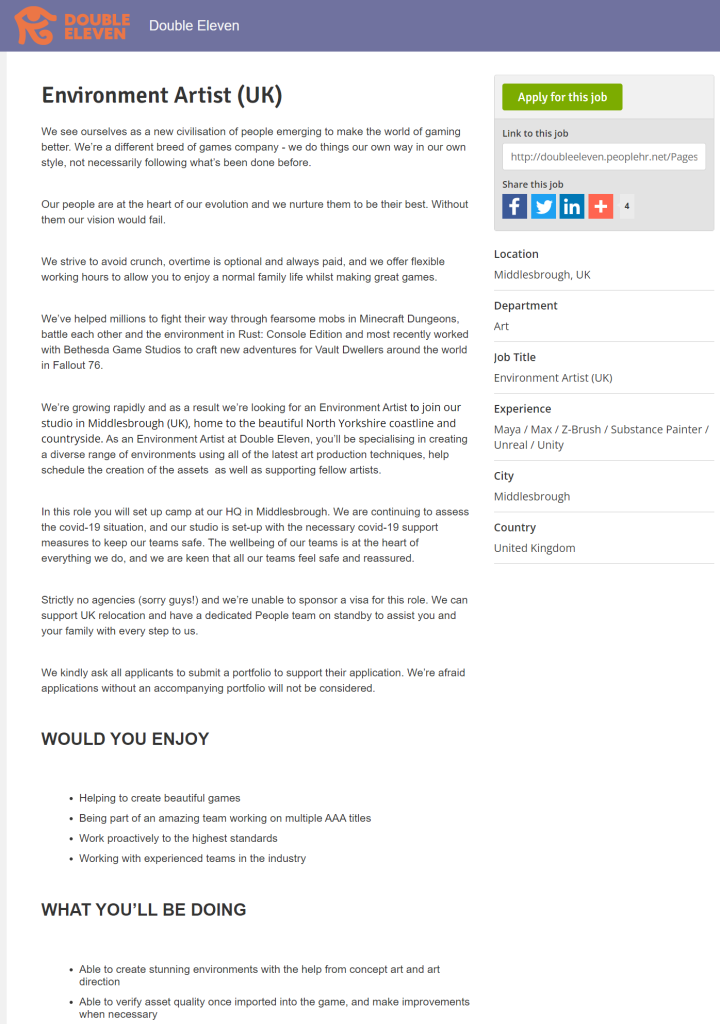Before I can begin crafting ideas for my environment I need to understand exactly what I need to show with the piece. I need to understand what studios are looking for in a portfolio piece before I can decide on what kind of environment will highlight these aspects.
:: Industry Research ::
Junior environment arts jobs seemed to appear online at roughly similar time of the year, which makes finding descriptions of specifically ‘junior’ environment artist roles difficult. To circumnavigate this, I’ll look to environment artist roles without the ‘junior tag’ and should a requirement specifying years in the industry previously worked I will ignore that requirement. This approach will also allow me to find requirements at studios which have 3D environment artist roles posted online currently. By identifying requirements present across different studio advertisements I can narrow down what i need to be able to show with my work.
:: Rebellion Games ::
Rebellion games are a well-established AAA games studio, creators of the ‘Sniper Elite’ series of games (Rebellion Developments, 2005). Which make heavy use of interesting environments both set in a specific time period (World War 2) as well as specific locations such as north Africa or Italy.


I feel I currently match the first few requirements listed for the role. Such as ‘experience with 3D software such as Maya and experience with sculpting packages such as ZBrush’, although I do hope to increase my knowledge of the latter through the assets produced for this project. I will need to research what is meant by baking textures and setting up material/shaders in real time render engines (in this case Unreal Engine).
In addition, I would like to fully understand what exactly is meant by ‘PBR material pipeline’ as I don’t currently understand what the term actually means or what differentiates it from any alternatives. I believe that this is the texturing process I have been shown and practice however I would like to fully comprehend what is meant by the term as it is present across almost all environment artist roles I have seen. I would also hope to demonstrate knowledge of good composition with things such as my blockout even before I start production. Perhaps by discussing how to approach this with industry contacts.
:: Activision Games ::
Activision games, creators of the ‘Call of Duty’ game series (Activision, 2003). Also create wonderful historical environmental settings. Below I have both the requirements for a ‘Junior’ environment artist role and a ‘Intern’ role of the same type.
The junior role (Ref.3) is surprisingly vague in its role requirements however does mention both 3D and 2D. Specifically Photoshop, which would be good to use in my texturing as currently I use substance painter almost exclusively to texture my models.


They also talk about a ‘awareness of game engine budgets’ which I interpret to mean knowledge of things like quality topology baking, which I am already aware of; as well as learning how to create and implement Lod’s (level of details) in my models’ textures when brought into unreal engine.
With the internship role (Ref.4) many of the requirements I would be expected to demonstrate should I apply are similar to the requirements shown in the Rebellion listing above (ref.1,2). An example of this is ‘Experience with creating PBR materials with high quality textures and efficient UV’s.’ Once again mentioning PBR, a term I hope to become more familiar with in this project.
I also need to learn what is meant by studios when they discuss ‘knowledge of composition’. This in my mind would have two different meanings for an environment intended to be used in a game and one made purely for the aesthetic for my portfolio.
For a 3D environment which is brought into a game the priority would naturally be making that environment engaging to a player. However, for a portfolio piece you are solely interested in the aesthetic. Many of the portfolio examples shown in my ‘Environment Ideas’ post would not be in any way engaging for a player to interact with but can create a wonderful visual. It would be good to discuss exactly what is meant by this with someone working in the industry.
:: Double Eleven ::
Double Eleven are a game studio who work with other studios on their IP’s. These titles range from ‘Fallout 76’ (Bethesda Softworks, 2018) to ‘Limbo’ (Playdead, 2011). There listing is again not for a junior role but does share many of the same requirements they would expect to see should I be applying to their studio.


Again, they specify ‘experience generating PBR materials and shaders’ as one of the requirements. This is a requirement I have seen in all three studio examples and others so this is something I will need my environments to show.
:: Defining my Project Goals ::
Having seen similar requirements listed for a few different studios I now know what I need to make sure my environment show. These are things like creating and using PBR materials and shaders, which I understand to mean using substance designer as well as substance painter to create things like ground textures. I have very basic knowledge of substance designer and so will likely need to source tutorials in order to create a texture good enough for my environment(s). I’m unsure what is meant by ‘shaders’ so this is something I will need to research the terminology of much like what ‘good composition’ is meant in these job listings.
All of the listings also specify ‘good knowledge of Unreal Engine’ or other game engines (unity). Which is why my environment needs to be rendered in UE5. However, this will require me to experiment and learn how to render and light a scene realistically in the engine software. I would also like to make use of VFX in order to clearly show a good knowledge of the software.
Two of the job listings also discuss ‘knowledge of Photoshop’ which is something I would like to explore in my texturing. I could do this by implementing decals into whatever environment I create.
I am unsure what is meant by ‘knowledge of baking textures’, specifically how to demonstrate that. So, this is something I will need to explore. It could be that this is shown through the process of creating LOD’s which is something I would like to explore and would show further knowledge of optimising an environment for unreal engine however I don’t want to take away from the overall aesthetic of the environment.
:: Summary ::
With this post I have explored what things are requirements of junior 3d environment artist job roles at a few different studios. This gives me an idea of what elements I should aim to show with my environment which will later help me on deciding what type of environment I want to create.
:: References ::
Activision (2003). ‘Call of Duty’ [Game Series]. Available online: https://www.callofduty.com/uk/en/ [Accessed 10/10/2022]
Bethesda Softworks, (2018). ‘Fallout 76’ [Video Game]. Available online: https://store.steampowered.com/app/1151340/Fallout_76_The_Pitt/ [Accessed 24/10/2022]
Playdead, (2011). ‘LIMBO’ [Video Game]. Available online: https://store.steampowered.com/app/48000/LIMBO/ [Accessed 24/10/2022]
Rebellion Developments (2005). ‘Sniper Elite.’ [Video Game Series]. Available online: https://store.steampowered.com/app/3700/Sniper_Elite/ [Accessed 10/10/2022]